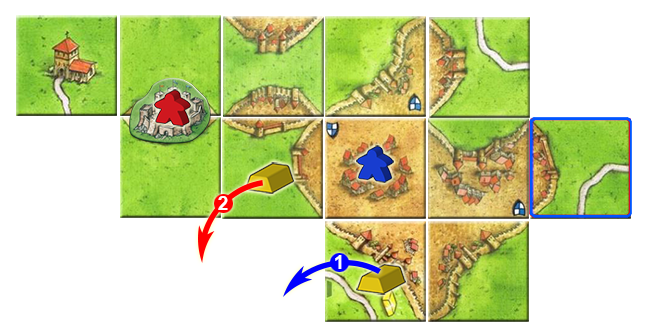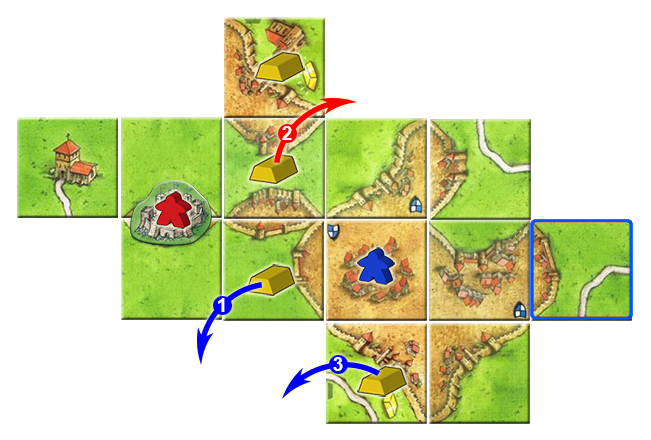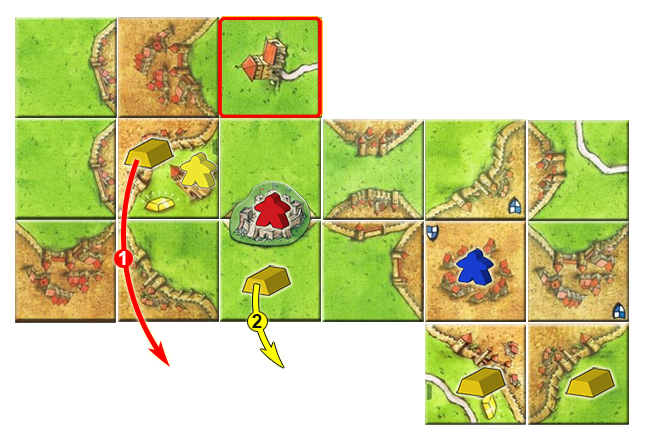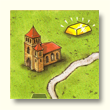The Goldmines (1st edition)
 |
You are reading the rules for this tile design. |
 | Read the following rules if your tiles look like this. |  |
| If your tiles have a different design, then choose a game from Spin-offs. |  |
GOLD! It drives everyone mad! All are trying to get their hands on this precious metal, even though its value is only known at the end...
General info and comments
 Expansion symbol |
Goldmines (Mini #4) was originally released by Hans im Glück in 2012.
This expansion has been developed for the Carcassonne basic game. All the basic game rules still apply in addition to the expansion rules below.
Contents
- 16 wooden gold pieces
- 8 new land tiles with gold logo
- 1 new land tile with crop circle
Rules
Preparation
The landscape tiles with the gold symbol are mixed with the other landscape tiles. The gold pieces are kept available for use.
Placing a tile
When a player draws a tile with a gold symbol, he or she plays it according to normal rules. Then the player must put a piece of gold on both the placed tile and one adjacent tile (diagonal is allowed). Thus, 2 gold pieces are placed for each gold tile played. A player is allowed to put a piece of gold on a tile that already has one or more gold pieces from a previously placed landscape tile. A piece of gold is never associated with a particular feature, but always applies to all features on a tile.
Deploying a follower
After gold placement, the player may still place a follower according to the normal rules.
Scoring a feature
If the tile with the gold symbol completes a feature after placing the tile, the feature is scored as usual.
Additionally, when a feature is finished and there are one or more pieces of gold on the tiles of that structure, these gold pieces are awarded. The player with the majority of the completed structure receives all gold pieces from the corresponding tiles. A road and a city include all tiles on which road segments or city segments are located. A cloister includes the cloister tile itself and all 8 adjacent tiles. [1] [2] [3]
When placing a tile and distributing gold pieces, proceed in the following order:
- Place (gold) tile
- Place gold pieces
- Place follower
- Score
- Award gold pieces
When more than one player has the majority in a finished structure when gold is to be claimed, or when several structures with a claim to gold are completed at the same time, the gold pieces are distributed among those claiming players. Distribution proceeds clockwise, starting with the active player, until all of the corresponding gold pieces have been awarded. [4] [5]
Each player places his gold pieces before him for the remainder of the game. The gold pieces will be scored during the final scoring.
Farmers receive no gold pieces.
Final scoring
When the game is over, all gold pieces which are still on landscape tiles are removed from the game.
The more gold pieces a player has collected, the more each individual piece of gold is worth, as per the following table
| Pieces of gold | Points per piece of gold |
|---|---|
| 1-3 | 1 |
| 4-6 | 2 |
| 7-9 | 3 |
| 10+ | 4 |
Final Scoring Example: [6]
RED earned 102 points and 7 pieces of gold in the game.
The gold is worth 7 x 3 = 21 points.
The final score for RED is 123 points.
Interaction with Other Expansions
The following notes clarify how Goldmines interact with a couple of major expansion.
Bridges, Castles & Bazaars
A castle lord can collect gold pieces placed in its vicinity. It does not matter if the gold pieces are not located on tiles occupied by the feature triggering the castle scoring.
![]() Question: Can a castle receive collect gold pieces placed in its vicinity the same as cloister collects gold pieces placed on the cloister tile or any adjacent tile?
Question: Can a castle receive collect gold pieces placed in its vicinity the same as cloister collects gold pieces placed on the cloister tile or any adjacent tile?
Answer: A castle can also take gold pieces, those located on its vicinity. The castle vicinity has 6 tiles: the two on which the castle was built, the two to the right and the two to the left of it. The castle lord can take gold pieces from them.
If there are several players entitled to gold pieces, the gold is distributed one by one, as described in the rules. (6/2013)
The following examples illustrate how gold pieces are distributed in some scenarios involving castles: [7]
- When scoring a castle, its owner can only collect gold pieces placed in the castle vicinity. Any gold pieces on tiles outside the castle vicinity will not be eligible even if they belong to the feature triggering the castle scoring.
- Players take turns when taking eligible gold pieces placed on the tiles of the features being scoring. Depending on the sequence followed, some players with eligible gold pieces may end up taking none.
- Example 1: Exploring various sequences
 Example 1A: RED completes the city occupied by BLUE, which triggers the scoring of the castle occupied by RED. As the active player, RED takes a gold piece first, and then BLUE. BLUE was also entitled to the gold piece taken by RED (placed in the castle vicinity and also on one tile of the city controlled by BLUE), but it was RED's only choice in this case. Therefore, BLUE can only take the gold piece at the bottom of the city.
Example 1A: RED completes the city occupied by BLUE, which triggers the scoring of the castle occupied by RED. As the active player, RED takes a gold piece first, and then BLUE. BLUE was also entitled to the gold piece taken by RED (placed in the castle vicinity and also on one tile of the city controlled by BLUE), but it was RED's only choice in this case. Therefore, BLUE can only take the gold piece at the bottom of the city.
 Example 1B-1: BLUE completes their city, which triggers the scoring of the castle occupied by RED. As the active player, BLUE takes a gold piece first and then RED. BLUE was also entitled to the gold piece taken by RED (placed in the castle vicinity and also on one tile of the city controlled by BLUE), and it was RED's only choice in this case, since BLUE took the gold piece at the bottom of the city.
Example 1B-1: BLUE completes their city, which triggers the scoring of the castle occupied by RED. As the active player, BLUE takes a gold piece first and then RED. BLUE was also entitled to the gold piece taken by RED (placed in the castle vicinity and also on one tile of the city controlled by BLUE), and it was RED's only choice in this case, since BLUE took the gold piece at the bottom of the city.
 Example 1B-2: BLUE completes their city, which triggers the scoring of the castle occupied by RED. As the active player, BLUE manages to take both gold pieces. BLUE takes the gold piece in the castle vicinity first (both RED and BLUE were entitled to take it), so RED cannot take any gold pieces. Finally, BLUE takes the gold piece at the bottom of the city.
Example 1B-2: BLUE completes their city, which triggers the scoring of the castle occupied by RED. As the active player, BLUE manages to take both gold pieces. BLUE takes the gold piece in the castle vicinity first (both RED and BLUE were entitled to take it), so RED cannot take any gold pieces. Finally, BLUE takes the gold piece at the bottom of the city.
- Example 2: Exploring best outcome
 Example 2A: BLUE completes their city, which triggers the scoring of the castle occupied by RED. There are two gold pieces in the castle vicinity, one of them placed on a tile of the city controlled by BLUE). As the active player, BLUE decides to take the gold piece in the castle vicinity which RED is also entitled to, so RED is forced to take the other gold piece in the vicinity. Finally, BLUE takes the gold piece at the bottom of the city.
Example 2A: BLUE completes their city, which triggers the scoring of the castle occupied by RED. There are two gold pieces in the castle vicinity, one of them placed on a tile of the city controlled by BLUE). As the active player, BLUE decides to take the gold piece in the castle vicinity which RED is also entitled to, so RED is forced to take the other gold piece in the vicinity. Finally, BLUE takes the gold piece at the bottom of the city.
BLUE gets 2 gold pieces and RED gets one gold piece.
 Example 2B: RED completes the city occupied by BLUE, which triggers the scoring of the castle occupied by RED. There are two gold pieces in the castle vicinity, one of them placed on a tile of the city controlled by BLUE). As the active player, RED decides to take the gold piece in the castle vicinity which BLUE is also entitled to, so BLUE is forced to take the gold piece at the bottom of the city. Finally, RED takes the other gold piece in the vicinity.
Example 2B: RED completes the city occupied by BLUE, which triggers the scoring of the castle occupied by RED. There are two gold pieces in the castle vicinity, one of them placed on a tile of the city controlled by BLUE). As the active player, RED decides to take the gold piece in the castle vicinity which BLUE is also entitled to, so BLUE is forced to take the gold piece at the bottom of the city. Finally, RED takes the other gold piece in the vicinity.
BLUE gets 1 gold piece and RED gets 2 gold pieces.
- Example 3: Triggering the gold piece distribution but collecting none
- When scoring a castle, its owner is only entitled to those gold pieces placed in the castle vicinity, even if they are not on tiles belonging to the feature triggering the castle scoring.
- Example 4: Features triggering the scoring are irrelevant
- Example 5: Sequence involving the building of a castle
 Example 5.4: BLUE completes their city, triggering the scoring of the castle occupied by RED. BLUE and Red will take gold pieces in turns. BLUE will take the two pieces at the bottom of the city and RED will take the two gold pieces in the castle vicinity, no matter the gold pieces are not on the feature triggering the castle scoring.
Example 5.4: BLUE completes their city, triggering the scoring of the castle occupied by RED. BLUE and Red will take gold pieces in turns. BLUE will take the two pieces at the bottom of the city and RED will take the two gold pieces in the castle vicinity, no matter the gold pieces are not on the feature triggering the castle scoring.
- When cloister in a castle vicinity is scored, its owner can take any gold pieces placed on its neighborhood. The neighboring castle, can only consider those gold pieces in its castle vicinity.
- Example 6: Exploring the scoring of a cloister overlapping a castle vicinity
 Example 6-1: RED completes the cloister occupied by YELLOW, triggering the scoring of the castle occupied by RED. RED and YELLOW will take one gold piece each, no matter the order they are chosen, since the two gold pieces are both in the castle vicinity and in the vicinity of the cloister (i.e. on the cloister tile or any adjacent tile).
Example 6-1: RED completes the cloister occupied by YELLOW, triggering the scoring of the castle occupied by RED. RED and YELLOW will take one gold piece each, no matter the order they are chosen, since the two gold pieces are both in the castle vicinity and in the vicinity of the cloister (i.e. on the cloister tile or any adjacent tile).
 Example 6-2: YELLOW completes their cloister, triggering the scoring of the castle occupied by RED. Yellow and RED will take one gold piece each, no matter the order they are chosen, since the two gold pieces are both in the castle vicinity and in the vicinity of the cloister (i.e. on the cloister tile or any adjacent tile).
Example 6-2: YELLOW completes their cloister, triggering the scoring of the castle occupied by RED. Yellow and RED will take one gold piece each, no matter the order they are chosen, since the two gold pieces are both in the castle vicinity and in the vicinity of the cloister (i.e. on the cloister tile or any adjacent tile).
The crop circles addition
In each mini, you will find a tile of the 7th mini expansion ![]() Crop Circles. This expansion is playable with only a single tile, but it is best to play with all 6 tiles. [8]
Crop Circles. This expansion is playable with only a single tile, but it is best to play with all 6 tiles. [8]
Tile Distribution
Footnotes
For Icons explanation and licensing please visit Icons page.
- ↑
 When a castle is completed, the owner can lay claim to gold pieces in the 6-tile vicinity of the castle: the 2 tiles upon which the castle is built, the 2 tiles to its left, and the 2 tiles to its right. The owner of the castle does not necessarily have the rights to gold associated with the feature that caused completion of the castle (unless that gold is also within the castle's vicinity or the castle owner
also has a majority in the primary feature). (6/2013)
When a castle is completed, the owner can lay claim to gold pieces in the 6-tile vicinity of the castle: the 2 tiles upon which the castle is built, the 2 tiles to its left, and the 2 tiles to its right. The owner of the castle does not necessarily have the rights to gold associated with the feature that caused completion of the castle (unless that gold is also within the castle's vicinity or the castle owner
also has a majority in the primary feature). (6/2013)
- ↑
 In general, any gold pieces on tiles of a completed feature will be distributed while the feature is being scored. Depending on the feature, the gold pieces involved may differ:
In general, any gold pieces on tiles of a completed feature will be distributed while the feature is being scored. Depending on the feature, the gold pieces involved may differ:
- Features distributing gold pieces on their tiles only:
- Roads
- Cities
- Features distributing gold pieces on the feature tile and its adjacent tiles:
- Monastic buildings: cloisters, abbeys, shrines, German monasteries (with a monk), Dutch & Belgian monasteries (with a monk), Japanese buildings (with a monk), Darmstadt churches
- Gardens
- Baba Yaga's hut
- German castles
- Cemeteries
- Haunted castles
- Features distributing gold pieces on the feature tile and the road tiles connected to it:
- German cathedrals
- Features distributing gold pieces on the tiles adjacent to the feature:
- Castles
- Features distributing gold pieces on their tiles only:
- ↑
 As a consequence of the rules, gold ingots on the tiles of a completed unclaimed feature will not be distributed, since there is no player controlling the feature.
As a consequence of the rules, gold ingots on the tiles of a completed unclaimed feature will not be distributed, since there is no player controlling the feature.
- ↑
 In general, if one or more features are involved, the active player (if entitled to gold) chooses the first gold piece and can choose any one of the pieces to which he/she may be entitled. The next player (in clockwise order) that is entitled to a gold piece can then choose an appropriate piece. Note that, because a player can choose which piece to take first (if there is more than one to choose from), a different player who may have initially been entitled to a gold piece may miss out if that piece has been claimed before it is that player's turn to choose. (6/2013)
In general, if one or more features are involved, the active player (if entitled to gold) chooses the first gold piece and can choose any one of the pieces to which he/she may be entitled. The next player (in clockwise order) that is entitled to a gold piece can then choose an appropriate piece. Note that, because a player can choose which piece to take first (if there is more than one to choose from), a different player who may have initially been entitled to a gold piece may miss out if that piece has been claimed before it is that player's turn to choose. (6/2013)
- ↑
 The RGG version of the rules states "players who score completed features with gold bars take one gold bar for each feature they score and that has gold bars." This seems different from the HiG rules, where the rule is to only take one gold piece at a time.
The RGG version of the rules states "players who score completed features with gold bars take one gold bar for each feature they score and that has gold bars." This seems different from the HiG rules, where the rule is to only take one gold piece at a time.
- ↑
 This additional rules clarification is from the
This additional rules clarification is from the  Big Box 4 edition of the rules.
Big Box 4 edition of the rules.
- ↑
 These examples are based on the clarifications provided by Kettlefish on the following threads, according to the clarification provided by Christof Tisch from 6/2013.
These examples are based on the clarifications provided by Kettlefish on the following threads, according to the clarification provided by Christof Tisch from 6/2013.
- Carcassonne Central: https://www.carcassonnecentral.com/community/index.php?topic=279.0
- Carcassonne Forum: https://www.carcassonne-forum.de/viewtopic.php?f=101&t=886
- ↑
 Note that the Crop Circle tiles included in the mini expansions are different from the tiles released in the initial Crop Circles expansion (referred to as "Crop Circles I").
Note that the Crop Circle tiles included in the mini expansions are different from the tiles released in the initial Crop Circles expansion (referred to as "Crop Circles I").

















